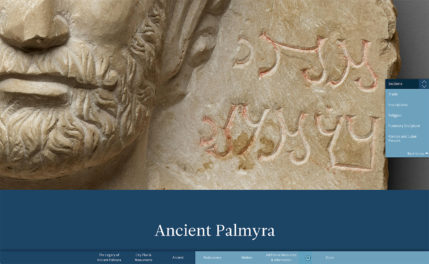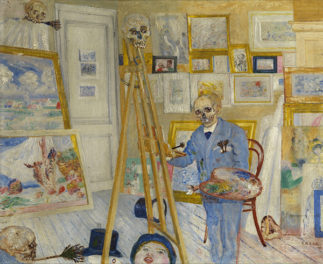
Untitled, 1986, Madoka Takagi. Platinum and palladium print, 9 9/16 x 7 5/8 in. 2009.81.1 The J. Paul Getty Museum. © Estate of Madoka Takagi
A double portrait by artist Madoka Takagi features herself, arms crossed, next to a shirtless man covered in tattoos, both gazing stoically into the camera’s lens. The work was made in the 1980s, but the matte surface, rich blacks, bright highlights, and wide range of tonalities are visual qualities associated with prints from a century earlier.
Takagi made platinum photographs, a process that was introduced and gained prominence at the end of the 19th century but was seldom utilized after WWI, to create formal portraits of friends, acquaintances, and cityscapes. Drawn from the Getty Museum’s permanent collection, the new exhibition In Focus: Platinum Photographs explores the rich history of the platinum photographic process and features several examples of prints by contemporary practitioners.
“Platinum printing was championed by prominent photographers shortly after its introduction partly because it permitted an unusually high degree of aesthetic expression,” says Arpad Kovacs, assistant curator in the Department of Photographs and the organizer of the exhibition. “Through experimentation, photographers like Gertrude Käsebier and Joseph Keiley learned how to manipulate the chemistry to create prints that resembled delicate drawings. This exhibition also highlights work made more recently by artists who continue to push the boundaries of the medium.”
What Is a Platinum Photograph?

Leopold Hamilton Myers as ‘The Compassionate Cherub’, about 1888-1891, Eveleen W. H. Myers. Platinum print. 9 5/8 x 11 7/16 in. 84.XP.728.26. Digital image courtesy of the Getty’s Open Content Program
British scientist William Willis Jr. developed the platinum process in 1873, and in 1878 he established the Platinotype Company of London to begin the commercial production of photographic papers and chemicals.
To create a platinum print, a negative is placed in direct contact with photographic paper that has been sensitized with a solution of iron and platinum salts, often applied by hand. After exposure, while the paper is submerged in the developer, the salts react to produce platinum metal in the exposed areas. The iron salts are then removed from the print in a clearing bath and the image is embedded in the uppermost fibers of the paper, resulting in a velvety, matte appearance.
Platinum Printing and Pictorialism
Soon after its invention, platinum printing became widely associated with Pictorialism, an international movement and aesthetic style popular at the end of the nineteenth century. Pictorialists favored visible marks of the artist’s hand that might be achieved by manipulating either the negative or the print, or both.
The visual qualities of each print could be individualized by changing the temperature of the developer or adding chemicals such as mercury or uranium. Photographers further enhanced their works by using an array of commercially available papers with rich textures, and by experimenting with techniques such as adding pigments and layered coatings to mimic the look of paintings and drawings. There were many ways to customize these prints, which added to their appeal.
These hand-crafted prints differentiated themselves from the crisp images produced by commercial photographers and snapshots made with hand-held cameras recently introduced by Kodak.
The Getty Museum acquired a number of rare photographs by artists associated with the Pictorialist movement in 2014. Among them is Edward Steichen’s La Cigale, a print that references Aesop’s fable of the grasshopper and the ant (in French, La cigale et la fourmi), in which the ant works all summer to build up its supplies for winter, while the grasshopper remains idle and unprepared for the season of cold weather.
Allegorical subject matter, long associated with genre painting, was an important source for many Pictorialist photographers. Here the marked reduction of contrast and the dense blacks were achieved by applying a coat of pigment on top of the developed platinum print to mimic the qualities of layered brushwork.

La Cigale, Edward Steichen, negative 1901; print 1908. Waxed gum bichromate over platinum print, 12 3/8 x 10 5/8 in. 2014.5. Digital image courtesy of the Getty’s Open Content Program

Untitled, 1903, Gertrude Käsebier. Platinum print, left: 7 3/8 x 5 7/8 in., center: 7/8 × 5 13/16 in., right: 7 5/8 × 6 in. 87.XM.59.1.1 Digital image courtesy of the Getty’s Open Content Program
Another work in the exhibition is a triptych of a mother and child by Gertrude Käsebier, one of the most technically innovative photographers associated with Pictorialism. Featuring a young mother with her toddler, this work is imbued with a sense of casual spontaneity and intimacy, qualities that make her photographs distinct from the highly staged and stylized images made by most of her contemporaries, including Edward Steichen and Frank Eugene.
Wartime: Decline and Resurgence of Platinum Photography
The popularity of platinum photographs declined in the years leading up to the First World War. The soaring price of the metal forced manufacturers to introduce alternatives, including papers made with palladium and a platinum-and-silver hybrid. As platinum became crucial in the manufacture of explosives, governments prohibited its use for any purpose outside the defense industry. The scarcity of materials and eventual shifting aesthetic preferences led many photographers to abandon the platinum process in favor of gelatin silver prints, which remained dominant through the 20th century.

Breton Onion Seller, London, negative 1950; print 1967, Irving Penn, platinum and palladium print. 2008.1.156 The J. Paul Getty Museum, partial gift of Irving Penn. © The Irving Penn Foundation

Dana Point, California, negative April 15, 2006; print April 25, 2010, Scott B. Davis, platinum and palladium print, 16 × 19 13/16 in. 2010.51 The J. Paul Getty Museum, gift of the artist. © Scott. B. Davis
Interest in the platinum process was renewed in the mid-20th century, and a relatively small but dedicated number of photographers continue to use the process today. The fashion photographer Irving Penn began hand coating papers with platinum in the 1960s and created prints with intense, detailed shadows and subtle, luminous highlights.
San Diego-based Scott B. Davis has been working almost exclusively with platinum and palladium for over two decades, and his atmospheric suburban night scene is on display. Davis notes, “Much as our ability to resolve fine detail is reduced in darkness, platinum and palladium prints uniquely capture this experience where visible objects disappear and enter the realm of imagination and mystery.”
In Focus: Platinum Photographs is on view January 21–May 31, 2020 at the Getty Center.




The tattooed fellow is Michael Wilson (1952-1996) “Wilson was one of the stars and linchpins of Coney’s sideshow cast circa 1987-1996, and brought a bit of grunge-y rock star glamor to the show. These were the years before EVERYONE had a tattoo; he was one of the people who made it fashionable in the modern era in the first place. He was also one of the performers during the same years I first discovered Coney and the sideshow, so I’ll always have nostalgic pangs when I look at photos of him from this period. There is a very moving website devoted entirely to Wilson here, with tons of photos, videos and articles about the man; he was clearly widely loved and is fondly remembered. He was only 44 when his life-long diabetes took him at the height of his fame. Today Michael Wilson is immortalized in Coney Island USA’s Sideshow Hall of Fame.” https://travsd.wordpress.com/2019/06/23/remembering-michael-wilson-the-illustrated-man/ and http://michael-wilson-the-illustrated-man.blogspot.com/
Thank you so much for sharing your insights and his story.
Hi,
Happy that interest in platinum image treatment is being appreciated in this show.
Does it include Mapplethorpe, Horst P Horst, Annie Leibovitz, Bert Stern,Roman Vishniac, Patrick Demarchelier? I was the printer of their works in platinum.
I also developed with the Arches Paper Mill of France the Arches Platine sheet now used by many platinum printmakers all around the world.
I am based in Connecticut and continue to make new works for leading photographers and artists.
Best wishes from Martin Axon